
I’d been ignoring the question for too long and ignoring the obvious implications of the obvious answer. Zack, how long can you gallivant in Costa Rica if you want to sail across the Pacific? Well, it depends on if I enjoy gambling. That smart-ass reply got me nowhere and extended my stay in Costa Rica. Sure you can sail anywhere, anytime, but a passage really hinges on the weather, and favorable weather depends on the season. Do you want to avoid cyclone season or not!? ... Ok, ok, I’m not a gambling man, I want to avoid cyclone season. Typically you want to be out of the South Pacific or in a hurricane hole by late November. Given that deadline, and the current date (practically July), I needed to start pumping out westward miles on Panache. Leaving within the week would put my arrival in the Marquesas sometime in the middle of August and allow me to spend a short amount of time soaking up land life before jumping to Tahiti ASAP with a potential stop in the Tuamotus, AKA the “Dangerous Archipelago!” (dangerous because of the low lying reefs and paranormal currents that have left many yachts crippled). Then to Bora Bora, on to Rarotonga in the Southern Cooks, 600 miles to Niue, half that distance to Tonga and finally a 1,000-mile jump down to Opua, New Zealand sometime in mid-November. Whoa. Sitting at my computer I could feel the overwhelming weight of the trip I hadn't even started. The jump to the Marquesas alone is almost 3,000 miles, and that only gets me halfway to New Zealand!
A headache started to develop, drilling deeper and deeper into the part of my brain that manifests anxiety. On my computer I can span thousands of miles effortlessly with only a deep breath and a fraction of a second, but acknowledging that my longest single-handed passage was under 400 miles made my meticulous yet quick clicking and scrolling a little more stressful. I had too many reasons not to jump, but I simultaneously had this overflowing drive to make something epic of my sailing trip. Mexico and Central America were extremely cool, but the inaccessibility and mystery of the South Pacific gives this portion of the world a whole different feel. Untouched, with plenty of undiscovered nooks to discover. Ending my trip in Panama or South America just wasn't a big enough statement. If I really wanted to elongate my trip, jumping to the South Pacific was my ticket.
If I wanted to overcome my immediate anxiety about the jump, I just needed to do it before I thought about it too much. My biggest flaw is my paralyzing need to overanalyze decisions, which almost always leaves me on the fence. A trip to a Subway sandwich shop can take hours. I am working on being more decisive, and this big decision would be a step in the right direction -- even if it was the wrong direction. If I don't leave soon, I might realize its a dangerous, foolish idea. Rebellious even. Ironically, if I gave into my fear, the trip would plague my mind materialized as regret. Regret and fear are without question thieves of tomorrow, and I wasn't about to let my brain cheat me out of this adventure! I prohibited my brain from recalculating the pros and cons and got busy provisioning. Before I closed my laptop, finished with the routing, my parting thought was that this was a brutal catch-22; the trip was dangerous, but I would regret it if I didn't go. Is a dead man better than one filled with regret?
For days, this catch-22 rang in my head like a lasting tang from a tuning fork. Provisioning wasn't too difficult, seeing that I had already provisioned for the jump in El Salvador and only needed fresh fruit and vegetables. Most of my last days were spent hanging out with Aaron and Nicole on Bella Star. They were docked at a nice marina still working out the lightning damage. It wasn't sad until I had to go, and then I really didn't know how to act. I had spent almost every day for the past six months with them, and now I was officially going to leave -- no second chances to pick up my lost camera on their boat, and no opportunities to reconnect down the coast. I was committing to the crossing. They visited me on my day of departure to say one last goodbye. They came bearing gifts: two slices of mouthwatering carrot cake (which I ate promptly) and a bag of coffee. We hugged goodbye awkwardly, not totally sure how to navigate the moment. I didn't cry and wasn't terribly emotional. Things like this tend to hit me way after the fact. In the coming days I would miss them more than I thought possible.
As I motored away we continued our goodbye over the VHF. I told them I had hid a present for them somewhere on their boat (1750 milliliters of Flor de Cana rum!) and we went through the departing lines of the characters in Gallipoli: “I’ll see ya when I see ya,” I said. “Not unless I see you first!” they replied. “Have a safe passage!” And just like that I was officially solo. Although I have been sailing solo since the Mexican Riviera, this was the first time I wouldn't have anyone familiar to meet me at my next port. I was alone, and the isolation grew with every mile I sailed away from Bella Star. A part of me felt totally ok about the departure because I knew I would see them again. Throughout all my Pacific planning I think I have inceptioned Bella Star into crossing next season. The hardest part was making them believe it was their idea to begin with. I don't know when I stopped looking behind me, but It was long after I said goodbye. I felt like I was sailing into the unknown. To an outsider this must sound silly seeing that I had ample information, charts and weather forecasts. I can only imagine how the first explorers felt when the idea of falling off the face of the earth was genuine. This thought settled my anxious mind. I knew I wouldn't sail off the edge of the earth, but I was still nervous. Like waking up from a long dream, my reality started to fade into focus. I was starting a Pacific crossing. Well, I was heading to Cocos then the Galapagos and then starting my Pacific crossing, but it was the first step, and one that turned out to be all up wind.
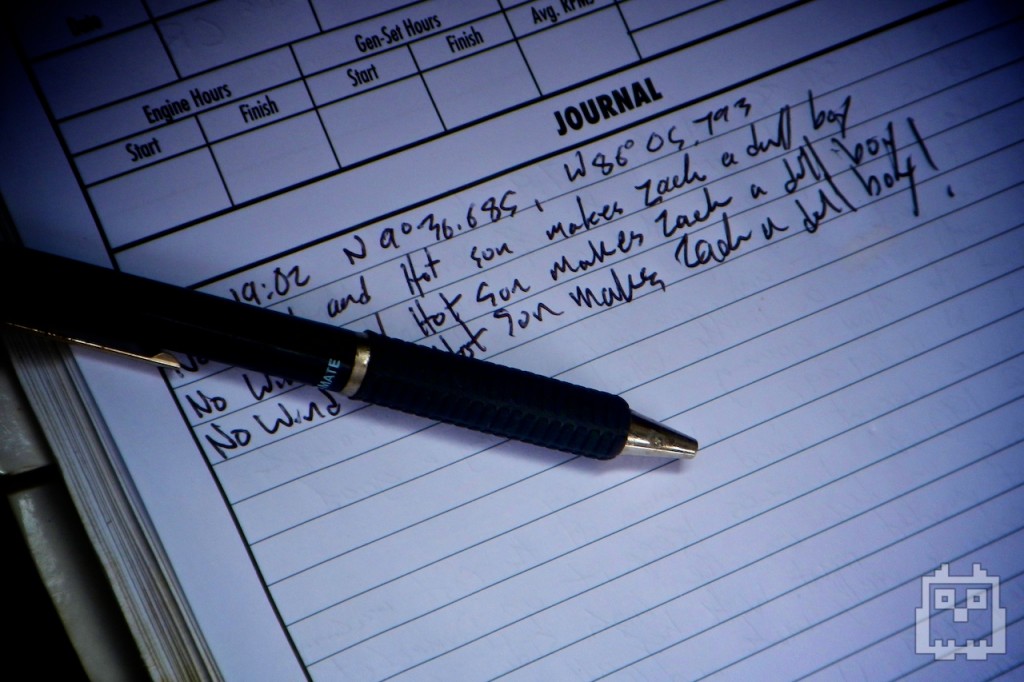
Within 24 hours I was experiencing the negative effects of the doldrums. I have mentioned the doldrums before, and like those previous references, the doldrums were anything but dull. The wind was a constant 20 knots on the nose, and every evening I had numerous active thunderheads to avoid and gales forcing me to reef abruptly. It was a lot of work that kept me up 24/7. Thanks to my previous gale experience on my way down to Costa Rica, I was a little more mentally prepared for the creeping force of doldrum gales, nevertheless, they still scared the hell out of me.
That second night out I was hit by two big gales one after another. My body was already leached of energy from acclimating to the uncomfortable sea state, and adding the shots of adrenaline from the gales just about crushed my spirit. The thunderheads were just the ingredient to send me over the edge. From previous blog updates you know my stance on lightning and thunder (I despise it with a healthy respect), but I have to reiterate: thunderstorms are of the most unequivocal forces of nature, but you need to get really close to realize this. The frequency of lightning in southern latitudes is more like a strobe light, and the thunder is so strong that even a deaf person can appreciate its power. I spent the next morning crawling around the boat like someone who hasn't eaten in weeks. Thankfully the headwind was not as strong, but to keep pointing as high as I could, I motor-sailed.
I lay down in the cabin to try and catch up on some much needed sleep, but to no avail. The motor was loud enough to penetrate the pillow wrapped around my head and the toilet paper that was stuffed in my ears, posing as half-baked earplugs. As loud as the motor was, a cacophony of noises were keeping me awake. I could hear the squeak of the boat from sailing upwind, Ouch, Ouch, Ouch, Ouch! The crashing of the waves flogging the bow. The dirty dishes I had ignored in the sink clanking back and forth and even the low whine of the auto tiller keeping me on a consistent course. All these noises were echoing in my skull. I couldn't take it anymore. I popped! Lurching up with a Grinch face on I yelled, “Just shut the fuck up!” I couldn't help laughing a little at such a ridiculous outburst. Being angry alone is a complete and total waste of energy. Not that it was apparent in this instant, but that outburst resulted in making me even more exhausted, and yelling at inanimate objects results in little to no reaction. The boat can’t absorb your anger and change. So what’s the point? Knowing anger is pointless doesn't stop fits of rage every once and a while, but to help rationalize this burst of emotion, I have personified many items on Panache. My rationale: If that annoying thing has a human name, it must be conscious and will thus naturally react to anger. I know Jesus, my self steering system, doesn’t react when I get angry at it, but it makes me feel a little better about my outbursts. Crazy? Definitely. A product of sailing solo? Absolutely. Do I give a shit? No.
As I lay on my back I tried to focus on one noise to try and drone out all others. The engine, the loudest noise, was the obvious choice, but I hated the sound. I decided to settle on Wanda, the auto tiller. She makes a low buzz that only clicks on when Panache drifts off course more than 10 degrees. The more I focused, the more I relaxed. Before long the buzzing transformed. No, it was more like a squeal or squeak and was entirely out of sync with Wanda. This wasn't the auto tiller at all! Dolphins? Too high-pitched. All this detective work was breaking my Zen sleeping exercise, so I went on deck to investigate. Scanning the horizon my vision stopped right at my starboard quarter where two huge black daggers stabbed out of the water like the ocean had grown horns. This snapped me fully awake. Whales. Killer whales. Orcas. I didn't even know they came this far south!? My excited smile faded into surprise as I discovered not two whales, but a whole pod. Whales sink boats all the time. Then my surprise faded into fear when one of the black dagger-like dorsal fins turned 45 degrees and started heading right for Panache. I held my breath and watched this massive black-and-white torpedo, almost as big as my boat, cut through the water directly for me. It was making an extremely high-pitched noise that made me want to cover my ears. If this sight (and sound) wasn't enough to make me pee my pants, the orca had a crushed dead sea turtle in its jaws. Everything about this event spelled disaster. Five feet before making contact with Panache, the whale dove, and I gripped the lifelines in preparation for a direct hit. The torpedo missed, and my whale friend was now crisscrossing under Panache screeching like a banshee. My heart was racing and my hands were shaking, but Panache was still floating. I can deal with that. The whales eventually lost interest in me and went on their merry little turtle-killing way. I later learned that this pod of orcas frequented Cocos Island and would habitually “show off” their kills to dive boats. One ranger told me how once an orca tossed a dead hammerhead shark 9 feet in the air right next to a dive boat before devouring it. Curious.
Shortly after my encounter with the black and whites, the headwind continued, and I was stuck tacking back and forth to make my destination. The weather and current were strange here. It felt like a no man’s land. Trash was floating everywhere, stuck between the two weather cells on either side of the Equator, and I just couldn't seem to make good headway. When a lull in the wind presented itself, I would turn on the motor and head right for Cocos. I was using an insane amount of diesel. The trip should have taken four days, but it took me seven.
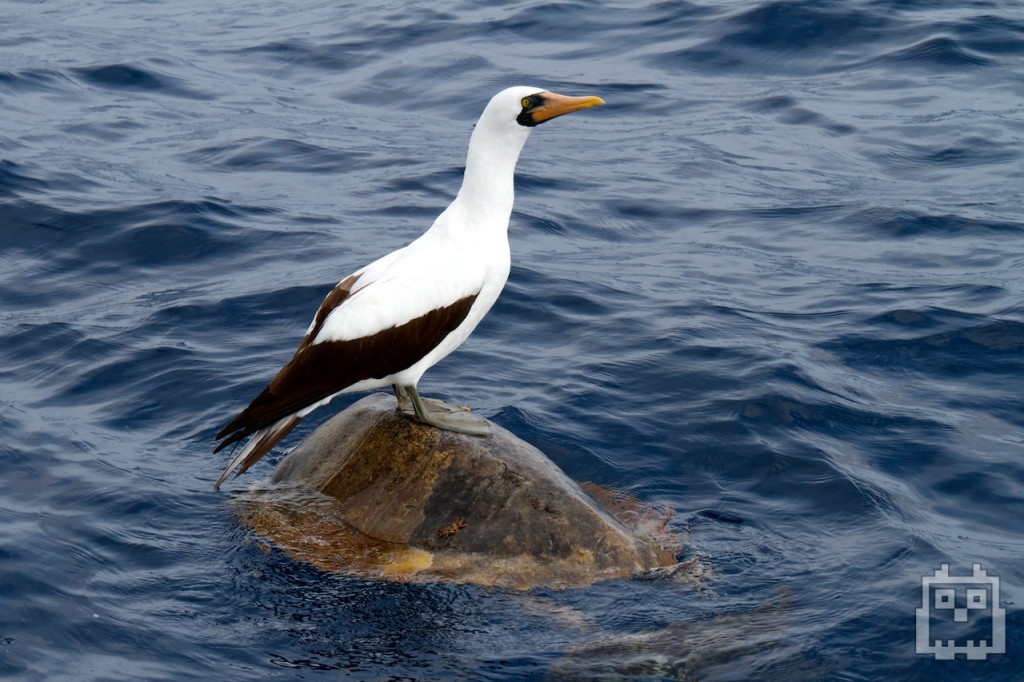
The last 40 miles to Cocos was the hardest. By day five I could see the island, but the wind was so strong that the island constantly outdistanced me. One minute I could see the vague outline of Cocos, and the next a huge swath of clouds would roll in and obscure my view completely. On top of everything, I hadn't been able to relay my position during most of the passage due to the electrical storms interfering with transmission. The thought of my parents worrying about me tied my stomach into an even tighter knot. During a weather break I was finally able to relay my position. The ham was even able to call my parents personally while I waited. After being constantly beaten down by my surroundings, the universe determined I had enough torment and allowed this little success. It was emotionally overwhelming. I was no longer alone in this battle. The maritime HF net was now with me, and so were my parents. I started to cry followed by laughter. I blame my emotional overload on my lack of sleep. I am a man and I don’t cry ... Unless I am watching Disney's Up ... or Forest Gump. I cleared with the frequency, gave the ham a heartfelt thanks, and took a deep breath. It would be another 36 hours before I arrived at Cocos.
Twenty-five miles out, a huge rainstorm descended on me. The wind got stronger and stronger and eventually forced me to cut all my sail area. I was now moving backwards in a complete torrential downpour. There was little swell, so the experience was as fun as it was odd. I took out all my dirty clothes and let them soak up the fresh water on the cockpit floor. I followed suit and stripped down for a nice shower. I was in the middle of nowhere, enveloped in a honey yellow cloud, showering buck naked in the rain. This is not a moment you want to encounter another boat. Thankfully I didn't, but it also didn't stop me from looking over my shoulder.
As the rain subsided, so did the wind. I gathered my laundered clothes and started the motor, gunning it for Cocos. Fourteen miles out I passed a city of fishing vessels lingering on the outskirts of the island, a national park where fishing was prohibited. Apparently this doesn't stop the fishermen, who fish inside the park boundaries but close enough to them to cross this invisible border if rangers are patrolling the area. Sneaky bastards. Five miles out the sun started to rise, spreading beams of light across the waves of greenery covering Cocos. In my land-starved state I’m sure any bump of land would be beautiful, but Cocos was breathtaking.
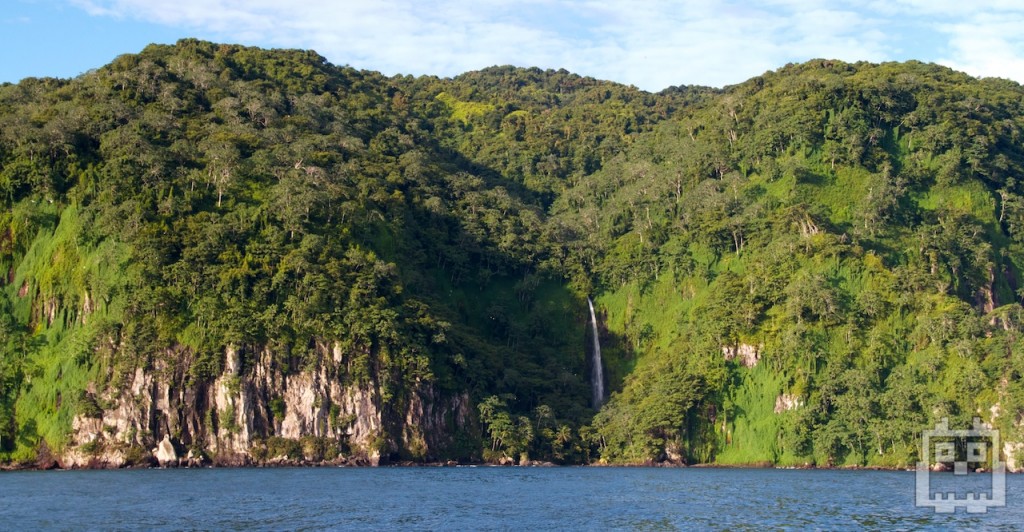
Cocos looks like the big island of Hawaii without all the resorts. The island is small and out of the way for the average traveler. Technically the island is part of Costa Rica, but it lies on the same latitude as Colombia!? I don't know how Costa Rica swings this, but it doesn't much matter. Upon my arrival rangers came out to visit me, already in the water stripping the grime from a 7-day passage. Saltbreaker told me sharks were in this particular bay, and the ranger reinforced this by instructing me to get out of the water for my own safety. The ranger hooked me up with a mooring buoy and helped me through the necessary paperwork to stay on the island. $25 a day to stay at the island, and another $25 for the mooring buoy. I was staring at an untouched tropical gem, I handed over payment confident in my purchase. Originally I was going to spend the day sleeping, but my eyes were feasting on a visual banquet I just had to touch, so I caught a ride into shore with Roberto the ranger.
The craziest thing about Cocos is that the island has satellite internet. So much energy is spent protecting the island from fishermen that it’s practically a requirement to orchestrate shipments of supplies and people to and from the mainland over the internet. After checking in with the world digitally, I began to feel the fatigue pull me into my computer monitor. It was a strange feeling that I had to fight, because in 10 minutes I was going on a hike to an adjacent bay with some rangers.
The land was saturated by the storms that I had battled for the past week, but today was sunny and cloud free. Ironically, the wind had decided to switch a full 180 degrees. I should have been frustrated about this, but I was busy scaling up a vaguely defined trail that skipped up the steep, muddy mountain side. Ropes were available for balance in appropriate spots, but overall it was sketchy. I liked that. Breaking into the first viewpoint gave a vantage over Wafer Bay where Panache was moored. I couldn't shut up about how beautiful it was. My two ranger friends who spoke no english just laughed, understanding without understanding.

The view got better and better as the hike continued. When we reached the other bay, we sat for a good 20 minutes to let our bodies rest and the view make its full impression. It was undoubtedly the most beautiful place I had cruised to thus far. I took more pictures than were appropriate, and I’m confident none of them will do Cocos justice. If you get a chance to visit, definitely take it.


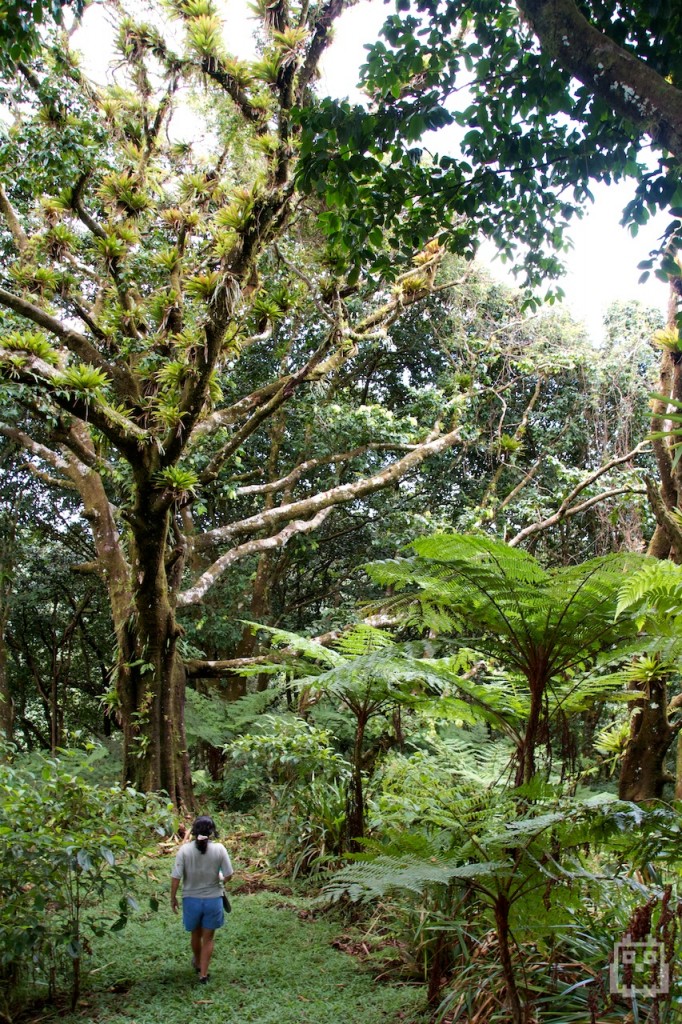
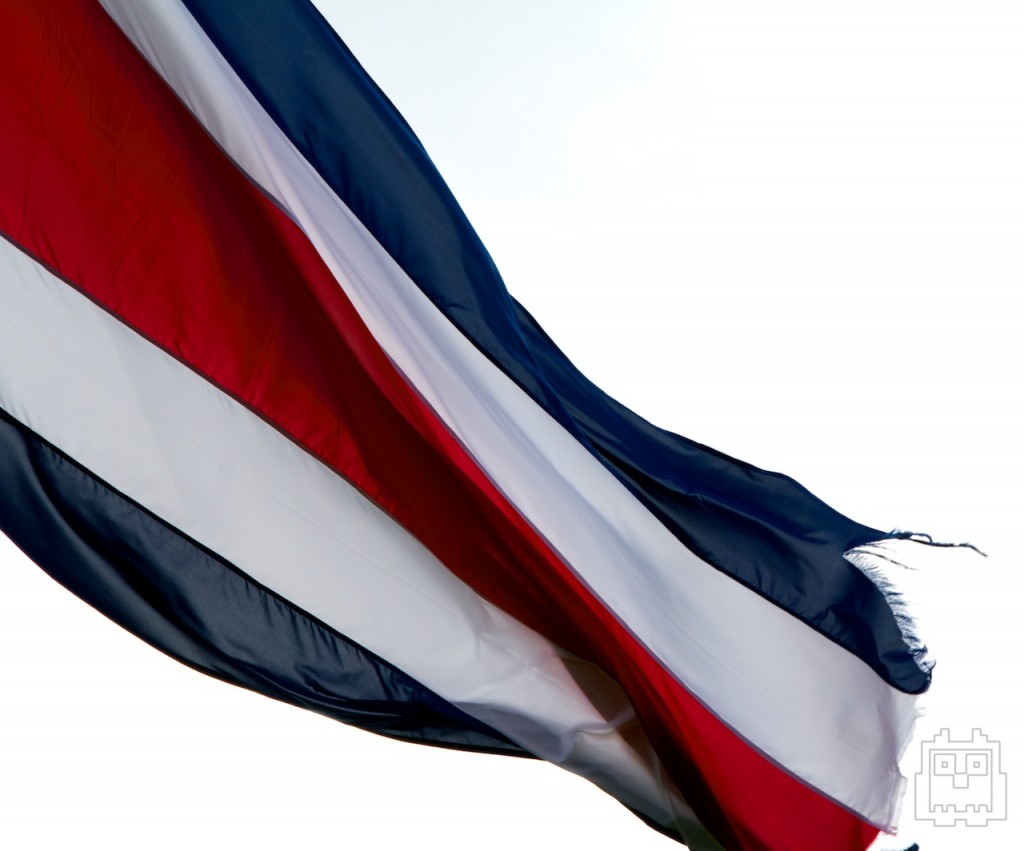
My tired legs were cramped by the time I got back to the rangers station, and instead of sleeping I decided to tag along during a snorkeling session with another group of rangers. The day kept getting better and better. Jumping into the water was a shock. I had snorkeled California, Mexico and the Costa Rican coast, but nothing prepared me for what I encountered here on Cocos. Having visibility beyond 50 feet would be enough, but since Cocos was so aggressively protected and didn't receive much traffic, that visibility was accompanied by fish, fish and more fish. And not just fish, big fish. Fish I encountered all the time in Mexico would be three time the size here. Lobster covered the seafloor, and white tipped sharks tussled between rocks. The snorkeling session wasn't long, but was long enough to understand why Cocos is said to have some of the best diving in the world. A scuba diver’s paradise. I slept well that night despite the not so protected anchorage.
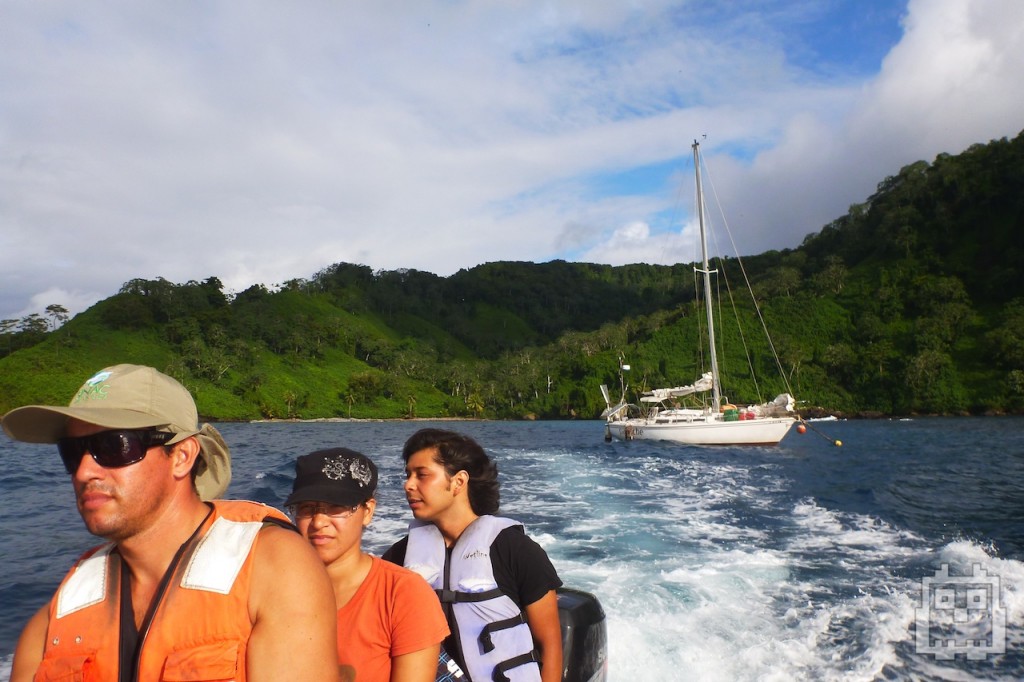
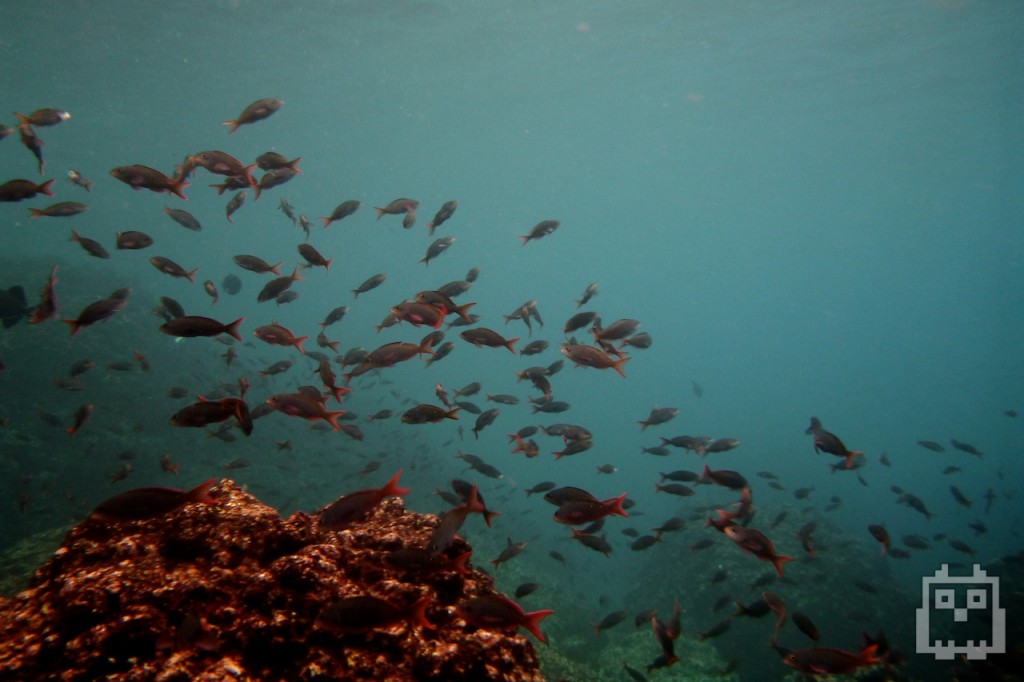
The next couple of days were rainy with moments of sunshine, but I had lots of computer work, so the weather wasn't important. The rangers took me under their wing and invited me to all their meals. I love cooking, but it was nice to take a break from the task let alone a break on land. I ended up spending four days on the island to use my remaining Costa Rican currency. I could have spent weeks there.
Internet was one thing, but fuel was quite another. No fuel station existed on Cocos, and I was running low on diesel. The Argo, one of the scuba boats, agreed to sell me 15 gallons. The day I was departing I rowed over to pick up the fuel, and my dinghy was followed by a pack of sharks the whole way. Initially I was a little scared, but they never bumped the boat and would swim off if I stopped rowing. When I arrived at the Argo I told the owner who informed me they were silky sharks that were looking for smaller fish using my dinghy as protection. Good to know. Avi, the owner, invited me for lunch. After a long question-and-answer session from the patrons of his boat, I got to ask some questions of my own. Avi made a similar passage when he was my age and spoke of it fondly. His past sailing experience is no doubt why he was so eager to help me with my current jam. With fuel in hand, I gave my thanks and farewell to Avi and crew and started gearing Panache up for departure.
I didn't feel ready to go, but I couldn't afford to stay another night. It was time to head back into the developing headwind to beat the 440ish nautical miles to the Galapagos. Motoring around the island I was immediately greeted by strong wind and rough swell. An hour into the passage I was seasick. This debilitating head-spin lasted for two days. I could sit on deck like a zombie, eat simple foods that required no preparation and lie down. It was a rough transition, but I’m figuring out that the transition is never easy. After that first night, the wind was clockwork and the squalls were nonexistent. Say hello to the SE Trade winds! I was happy to have consistency, but the wind was still barreling down on me doubling the ground I had to cover. I started taking tabs on how many miles I sailed vs. how many miles I gained towards the Galapagos and discovered I needed to sail two miles for every mile of headway. Woof.
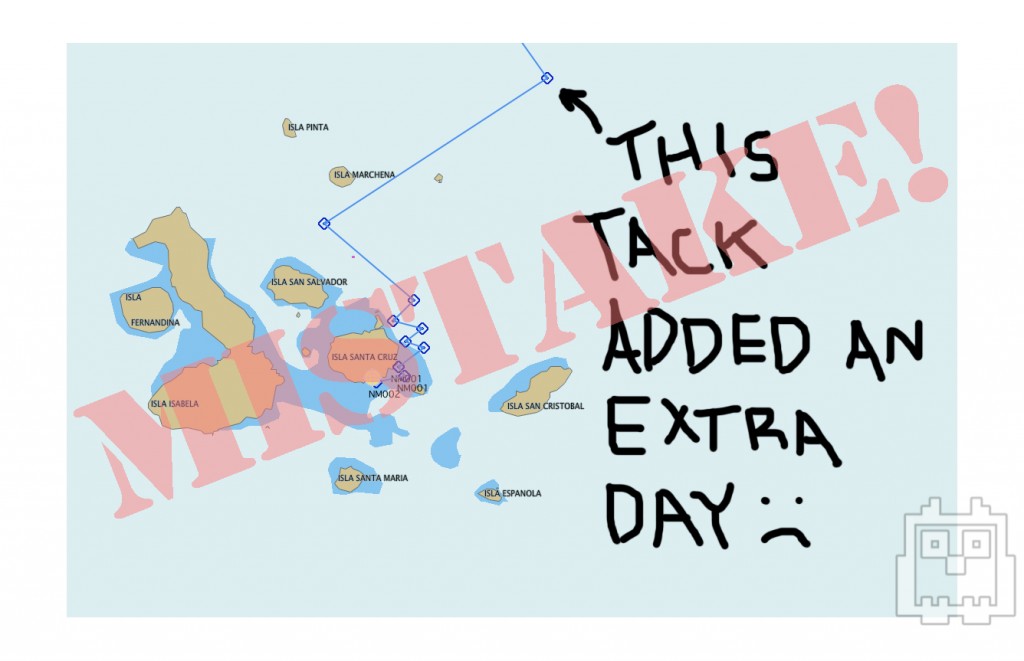
When I got close to the Galapagos, I started making foolish navigational errors. I made one tack that ended up making me fight the prevailing current. This one tack added a whole extra day to my passage. A little over nine days later I landed in Academy Bay on Santa Cruz Island just as the sun was setting. The anchorage was oddly shaped and jam packed with huge tour boats muscling for the best-protected nook. Being a small 30-foot boat, I confidently wedged myself through the traffic and found a perfect spot close to the public dock. I secured my anchor, put on some deodorant and inflated the dinghy to go ashore for a calorie-packed late-night dinner.
I got some interesting looks rowing up to the main dock that was buzzing with water taxis, but I enjoyed the attention. Clean cut tourists wearing what looked like safari getups stared at my crappy little dinghy and unshaven mug. Yeah I sailed to the Galapagos! I felt pretty good about myself. My dream meal turned out to be a family-sized pizza and a beer to match. The restaurant had internet and allowed me to ping family and friends of my arrival. Not dead yet! I knew Galapagos was expensive, so I already planned to get all my chores done by Sunday so I could leave Monday. Four days of busy work should be enough to get ready.
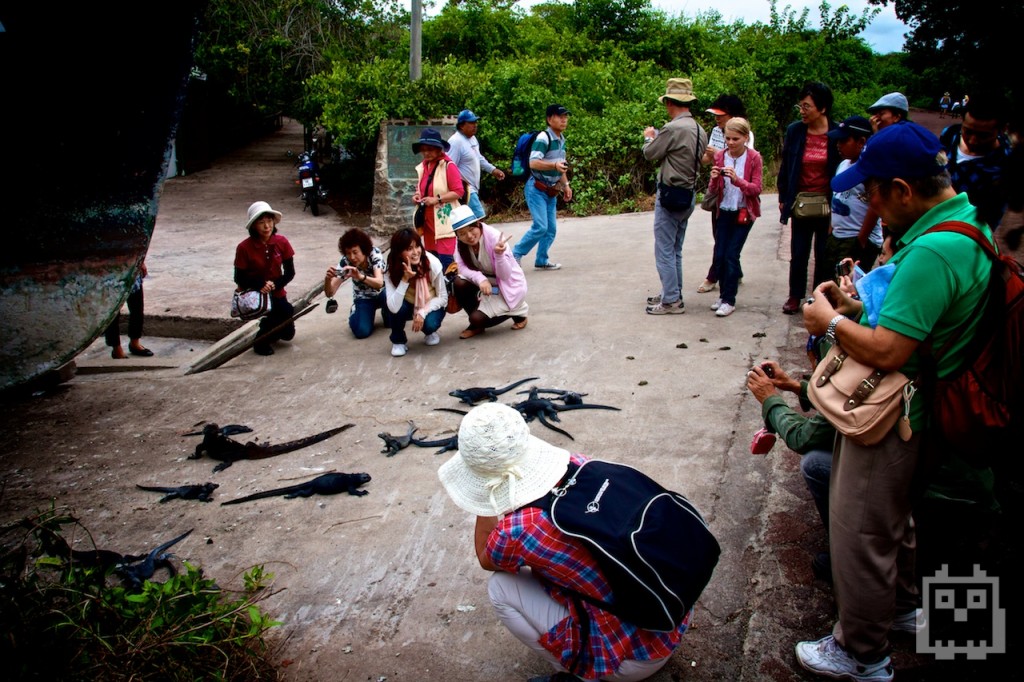
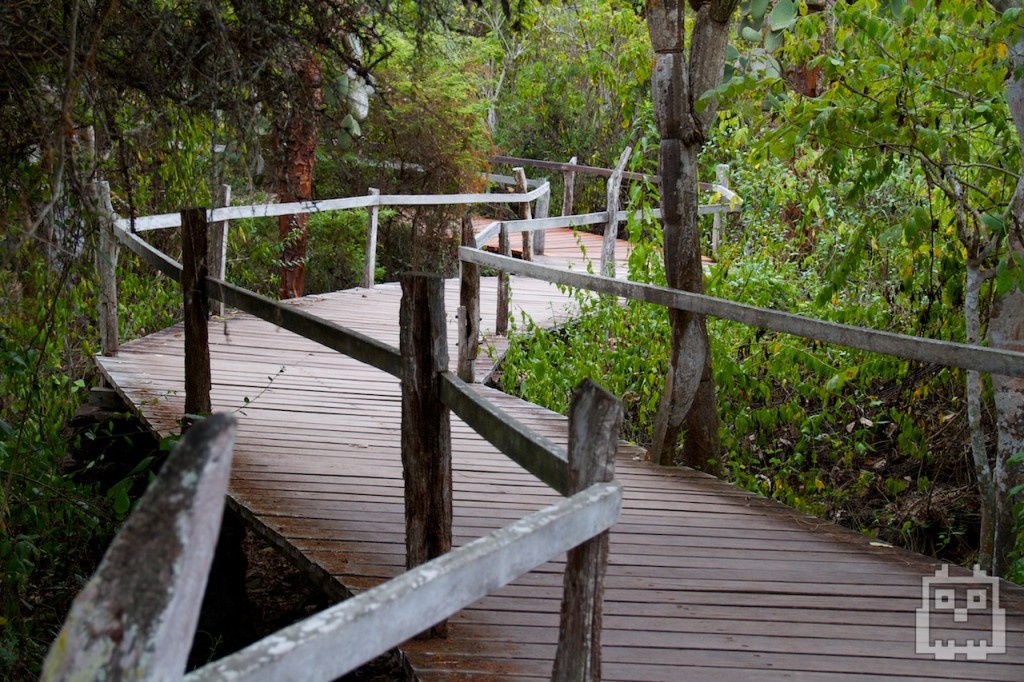
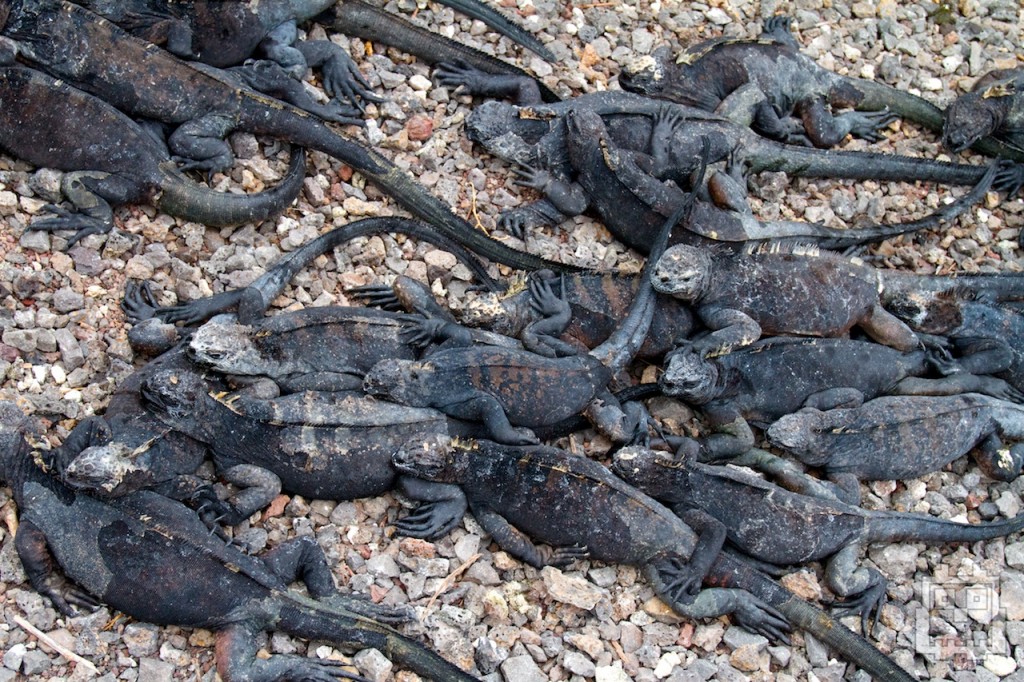
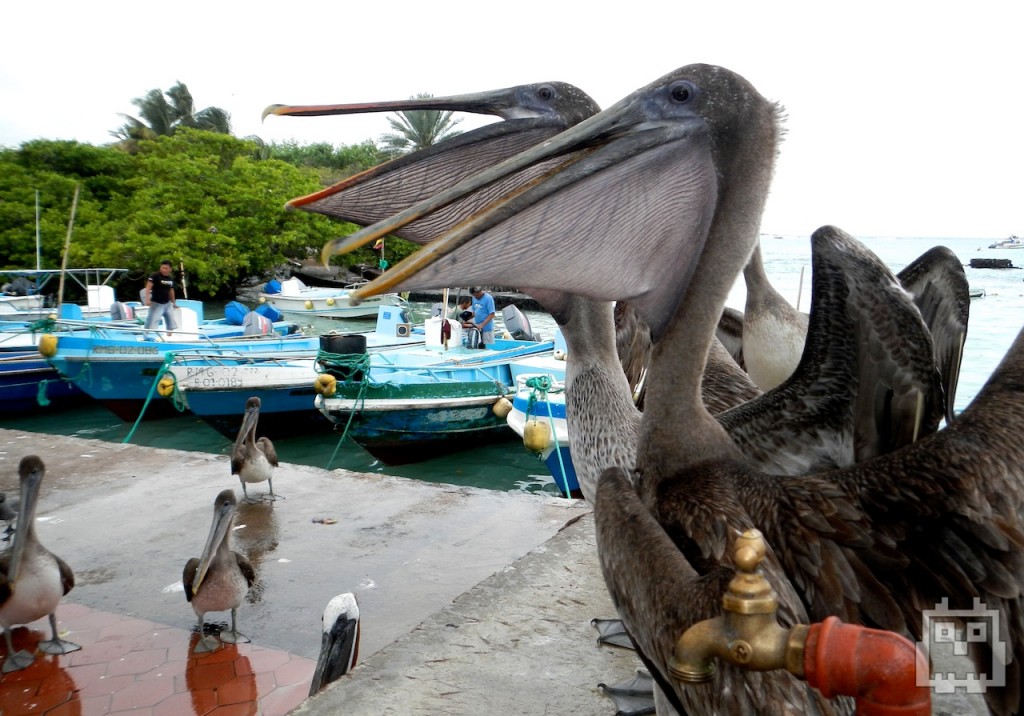
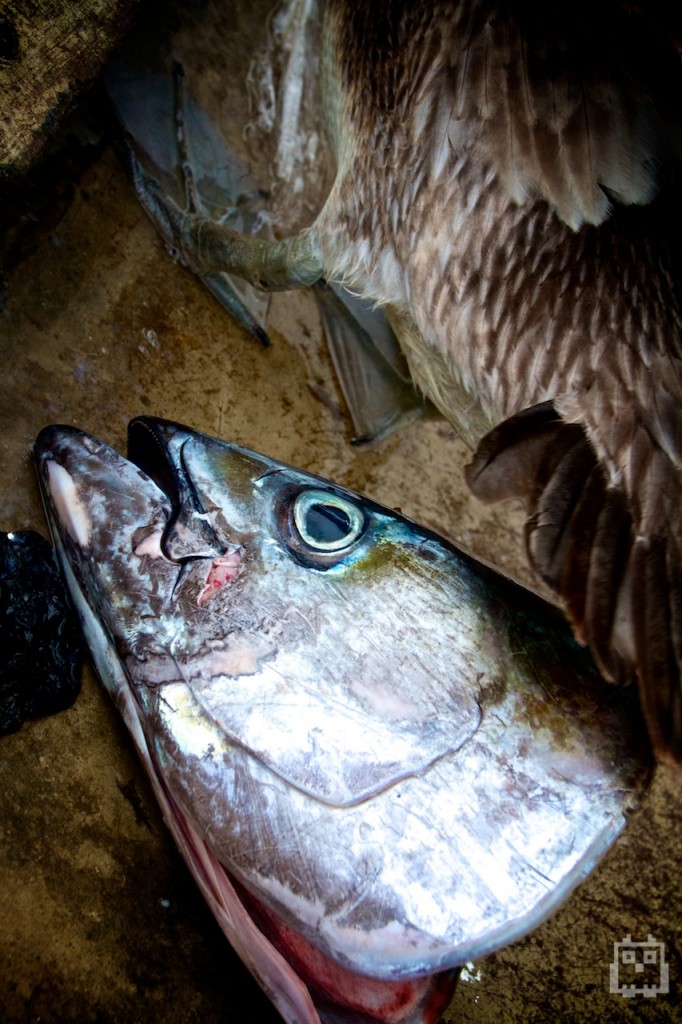
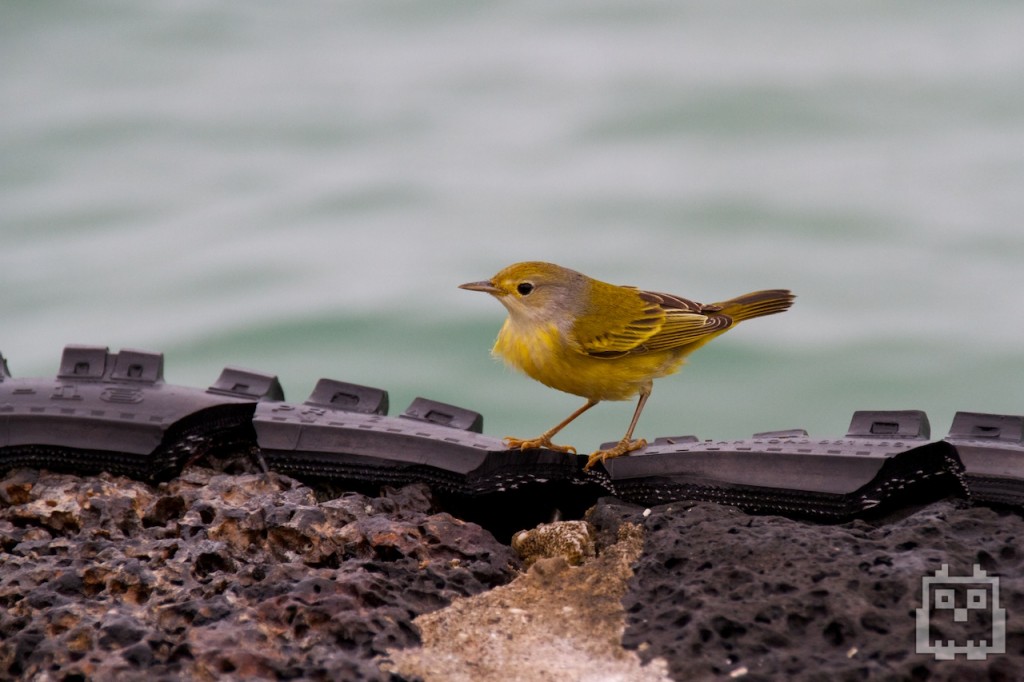
I did my best to ignore the port captain, Maybe I could slip unnoticed. But the second day he found me. When I lifted my head from my pillow there he was on my boat. Hola. In all Spanish he explained the logistics of mooring in the Galapagos. He sounded a little frustrated how bureaucratic the whole thing was and then with a puckered face wrote down all the fees. Line item after line item tallied to 430 American Dollars. I looked at him with a stupid look on my face and said, “I need three things: fuel, food and sleep. That’s it.” He smiled, got out his phone and got me an agent to handle everything for $200. I’m not sure if that’s a good deal or not, but my agent also helped me source everything I needed for my jump, so I had no issue with paying.
Those four days went by so quickly. The morning I was scheduled to leave, I came ashore one last time for breakfast and weather forecast information. An egg omelet, some delicious espresso and 15-20 knots of wind from the south. This was going to be the last time I would have a prepared meal for a long time. The last of many things. You can prepare for the rest of your life, but if you never take that jump, it’s all for naught. I was nervous. Scared. Anxious. But ultimately I had done more dangerous things for less compelling reasons. I lifted my anchor and headed for the mouth of the harbor. Here’s to the unknown.
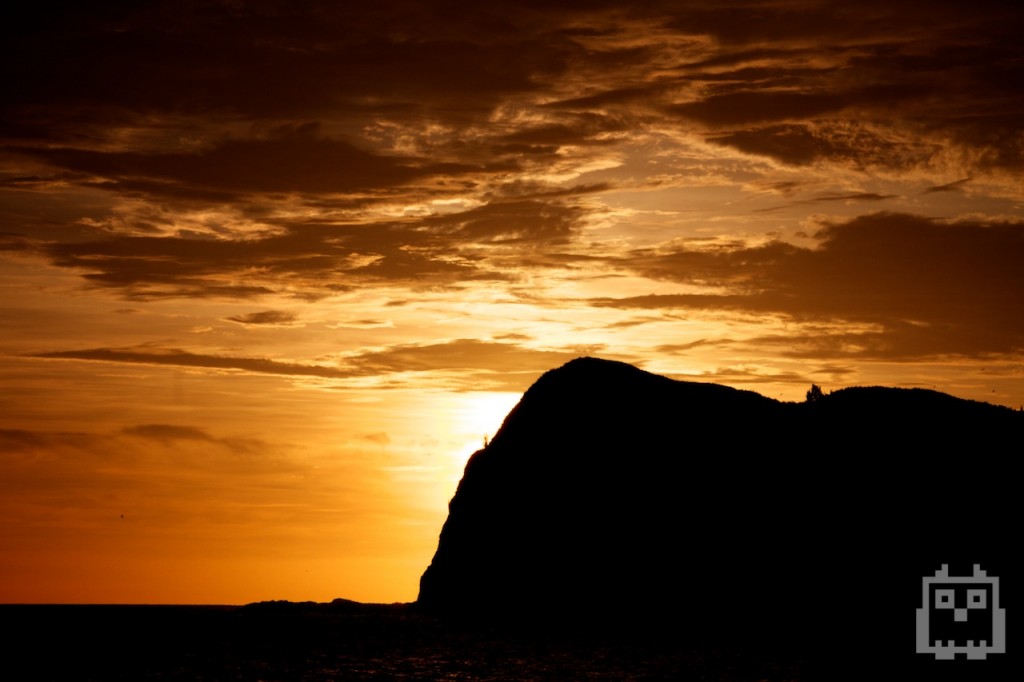
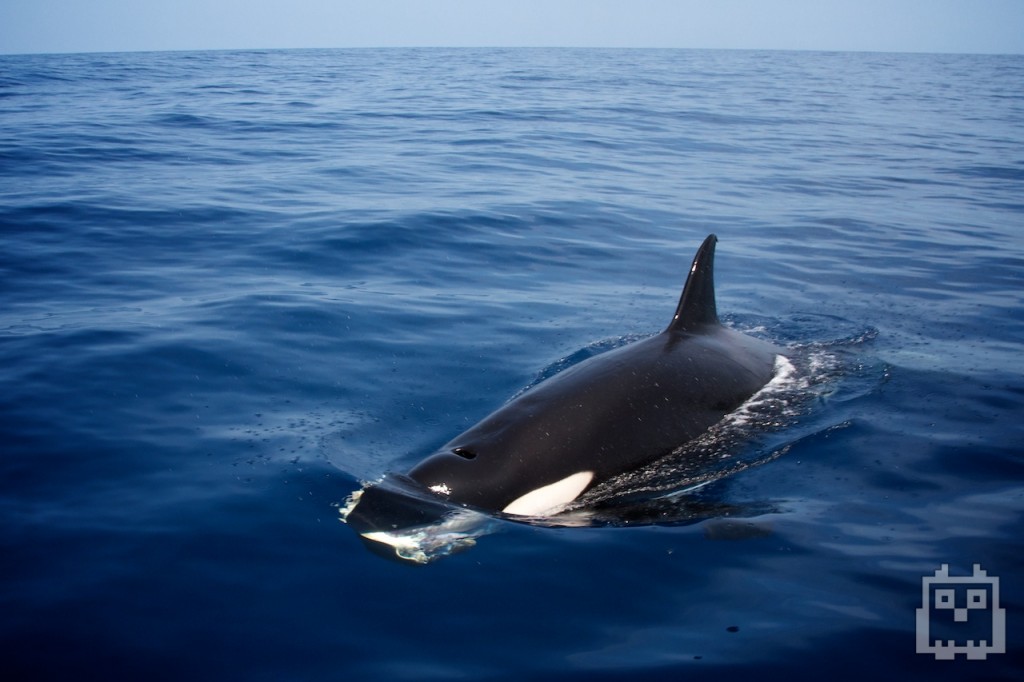
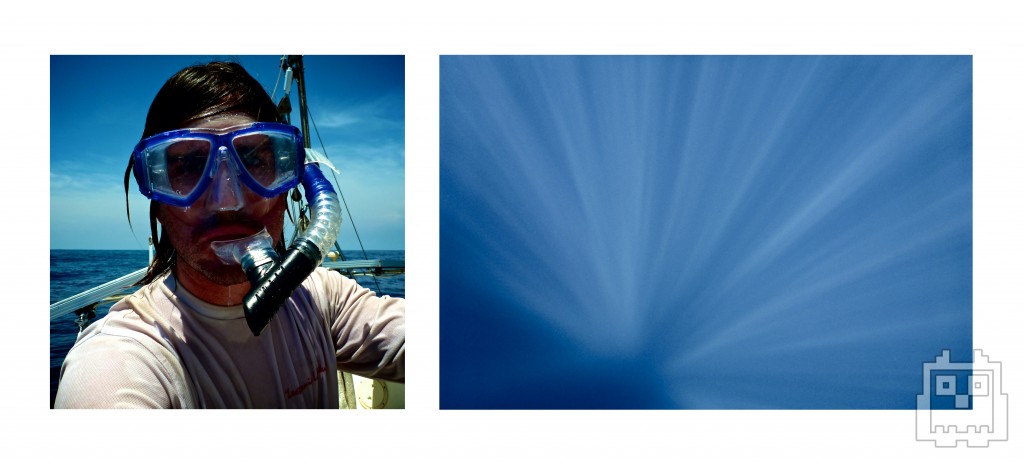
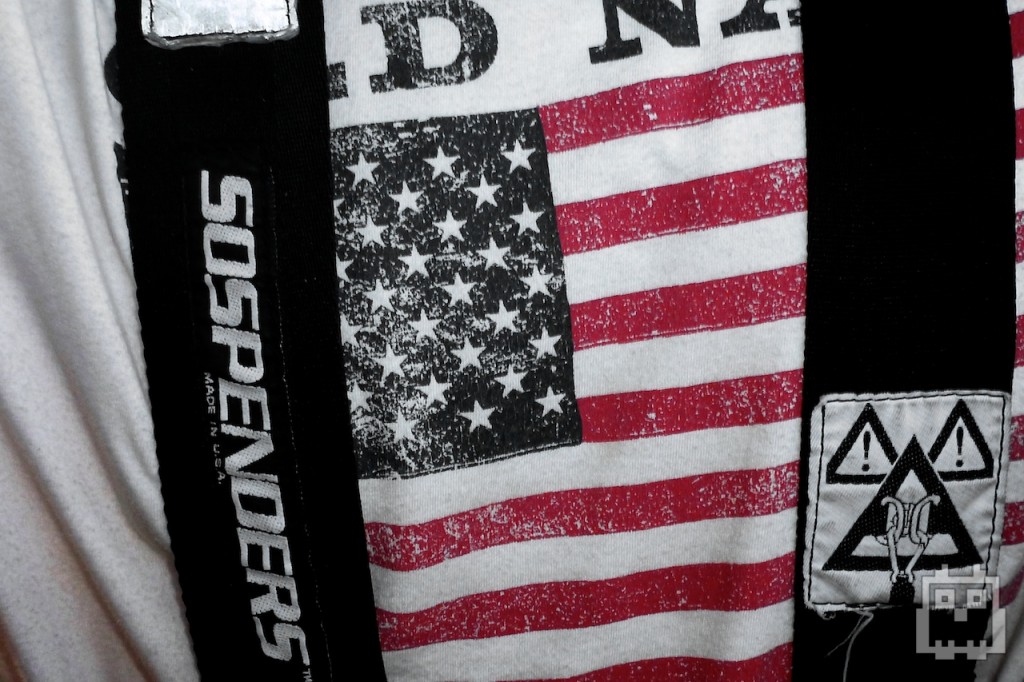
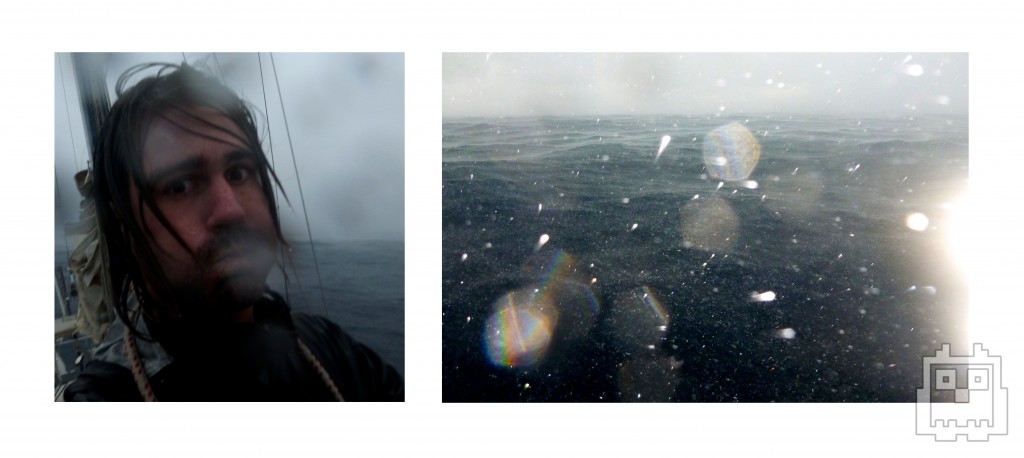
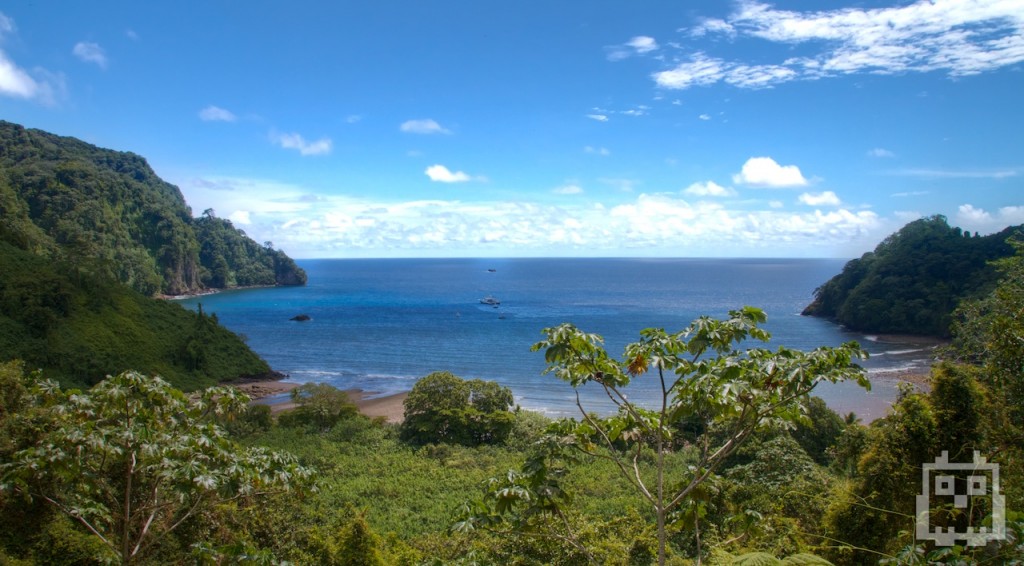
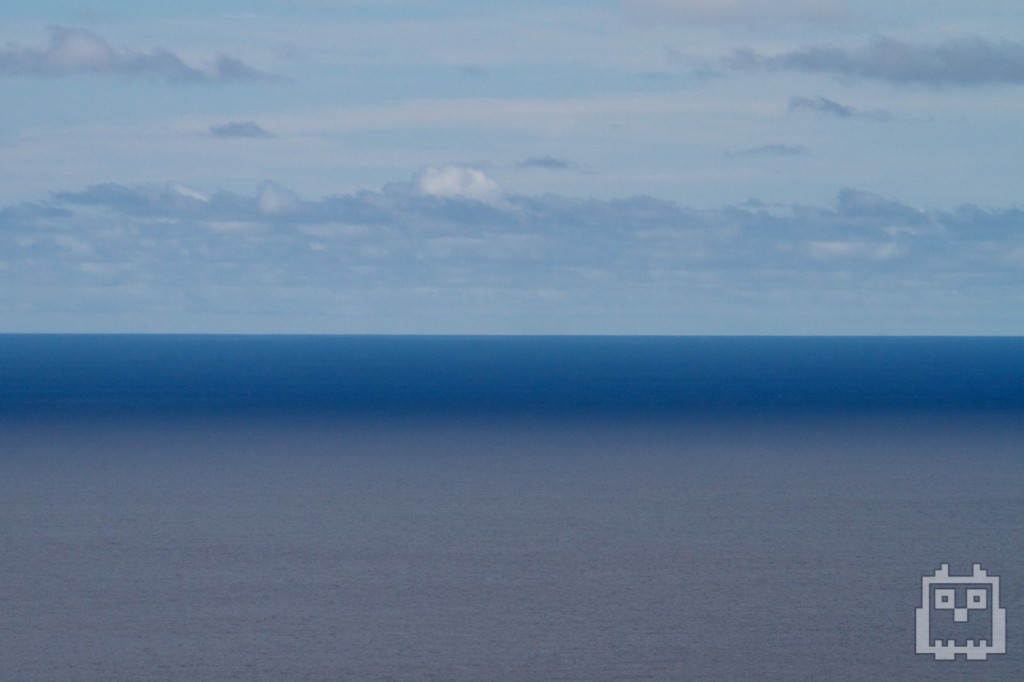
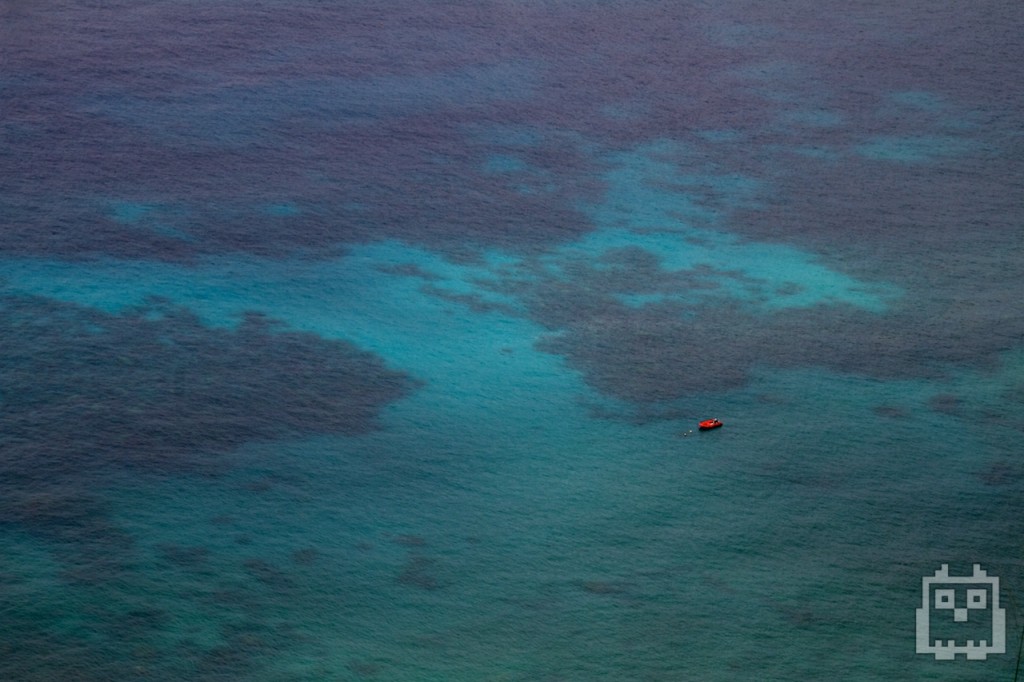
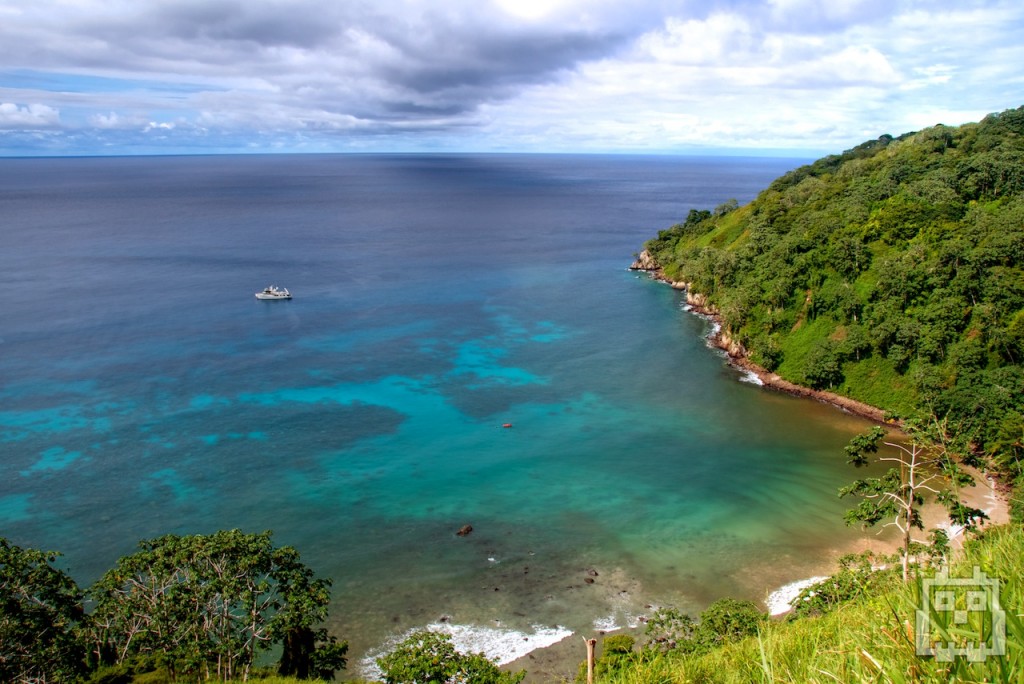
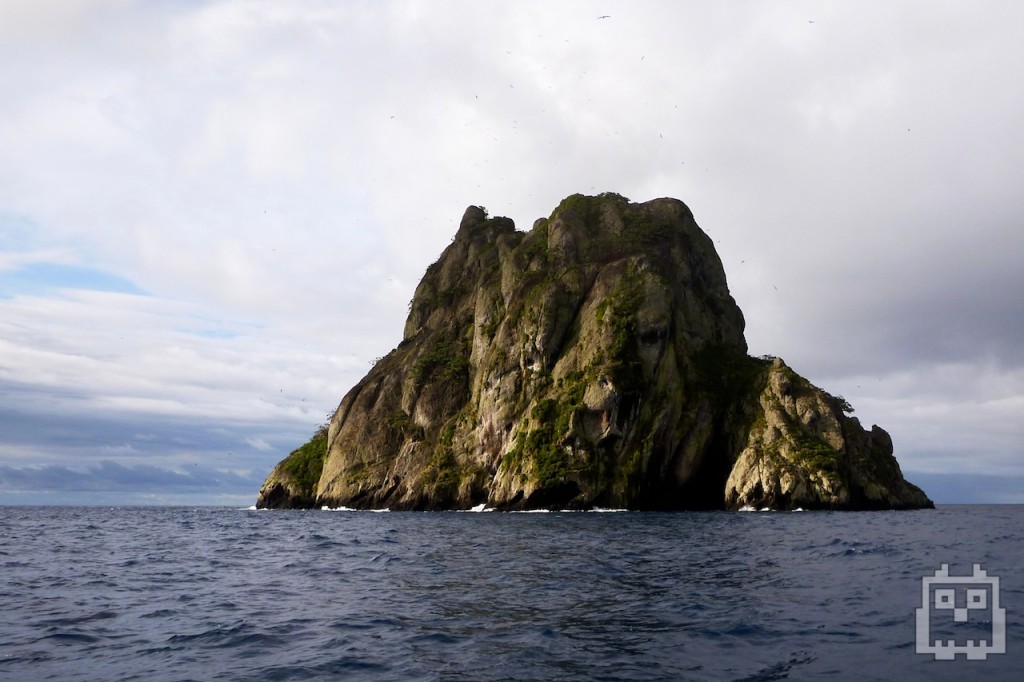
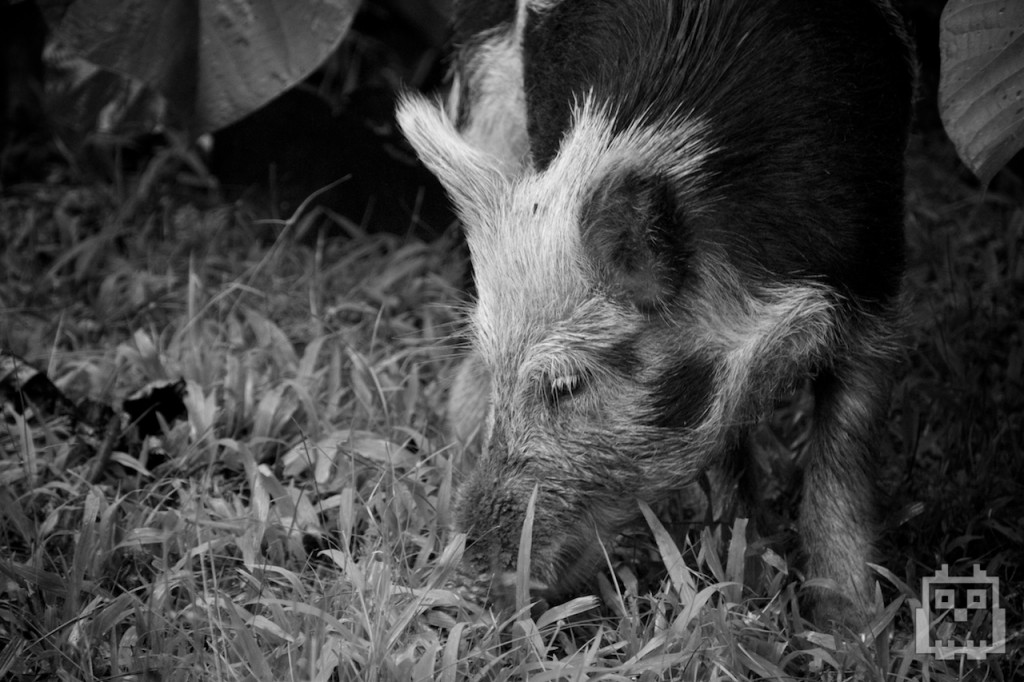
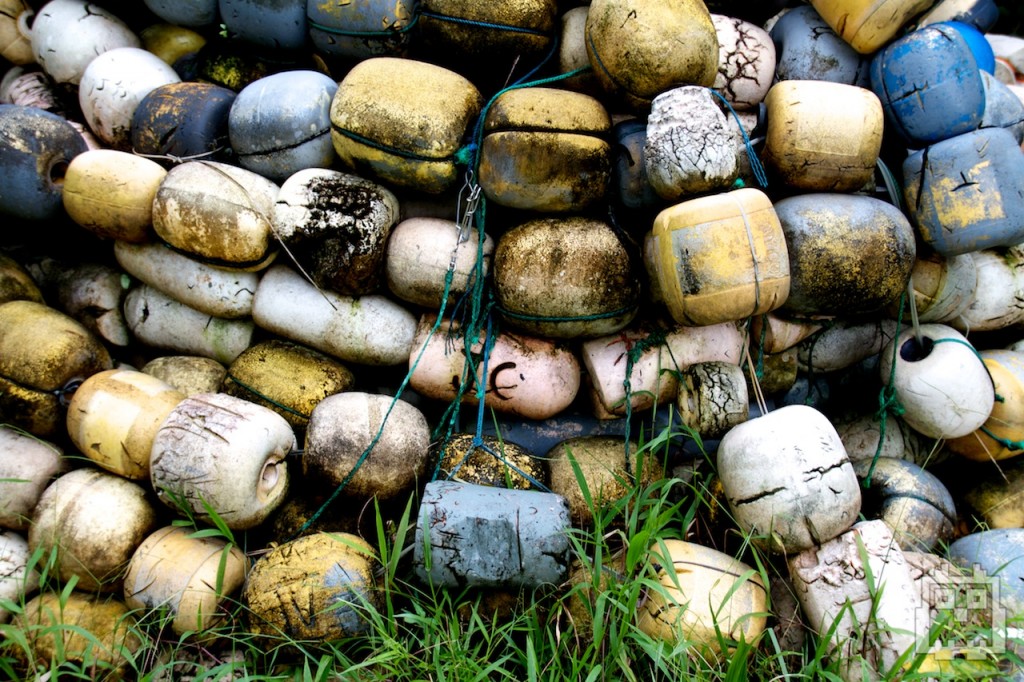
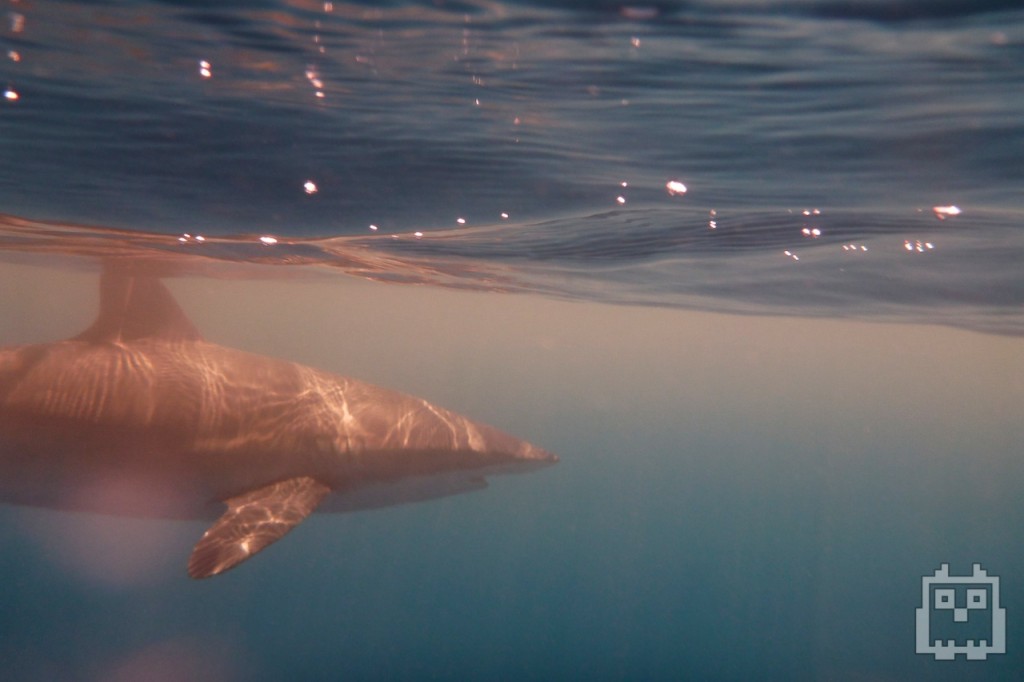
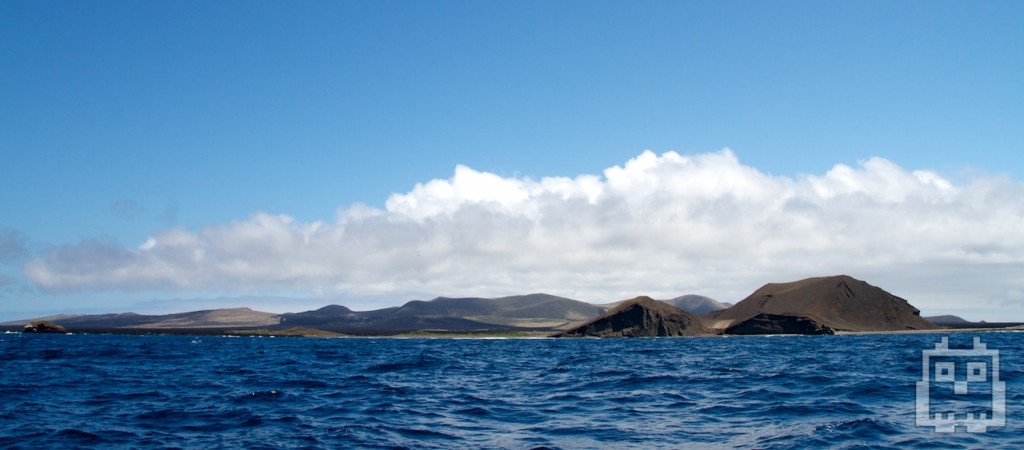
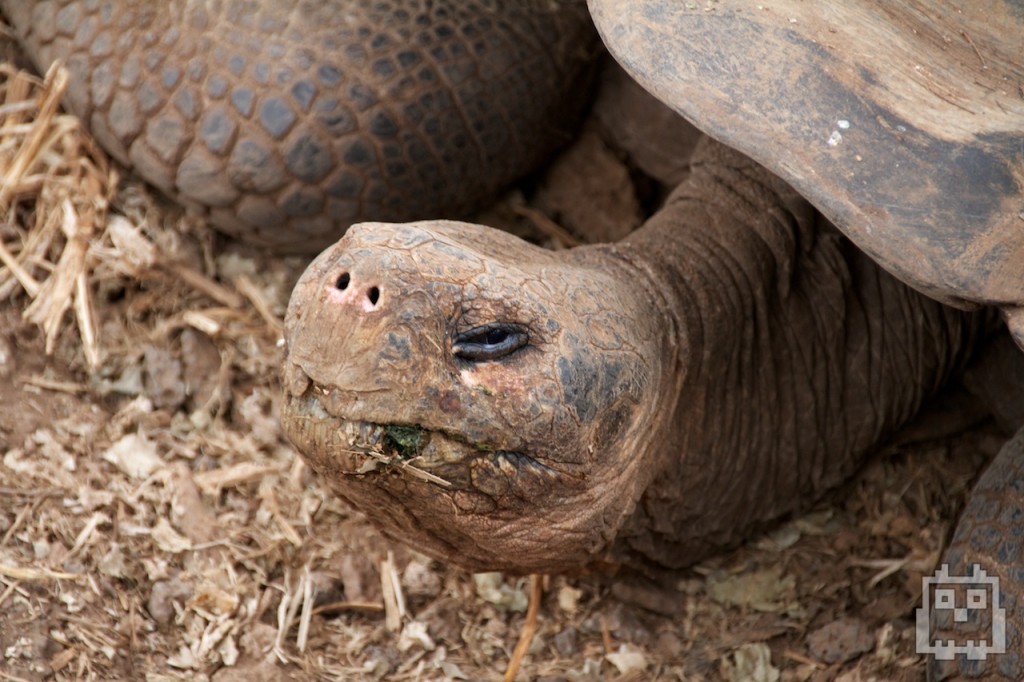
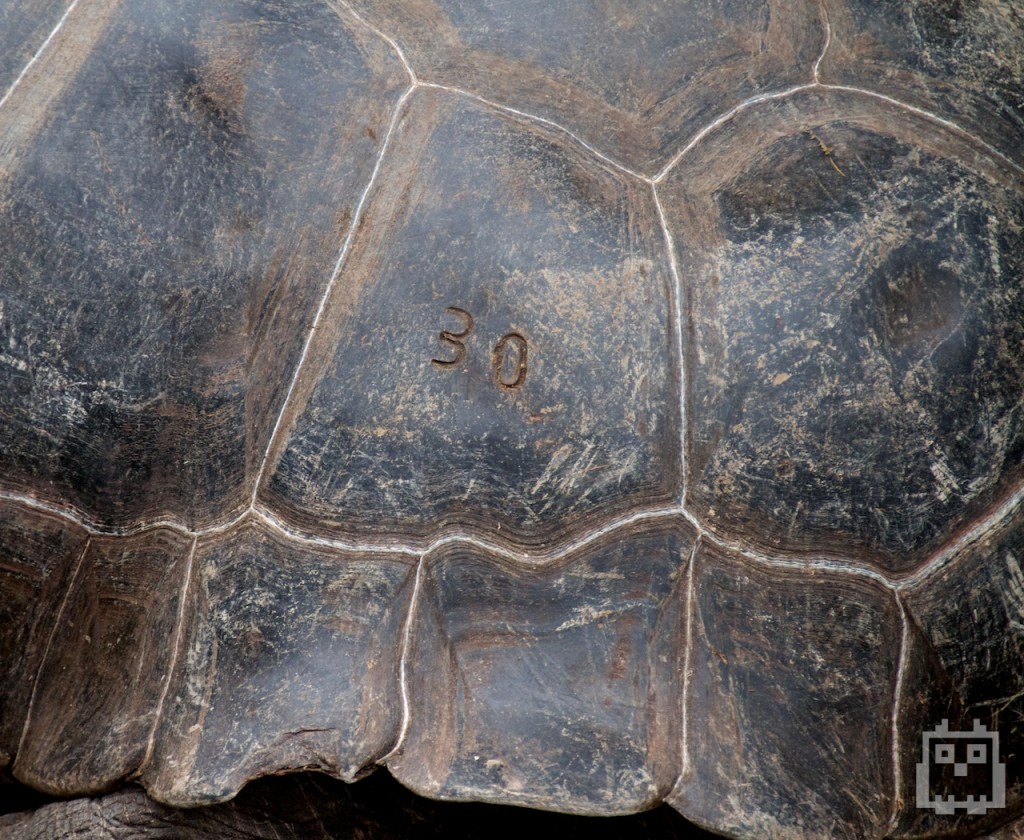
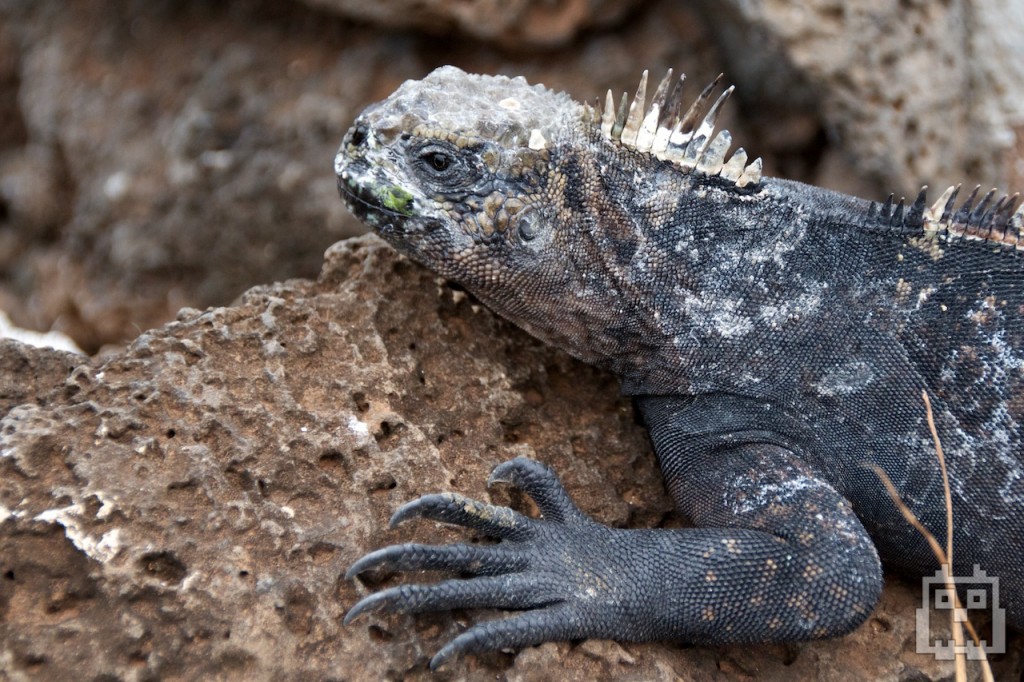
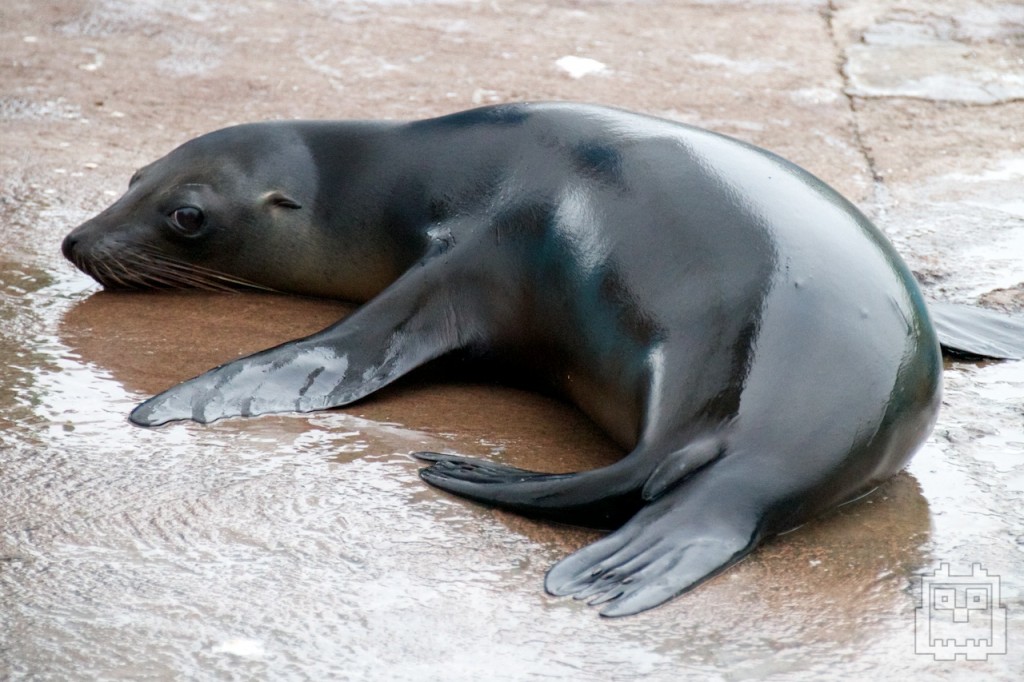
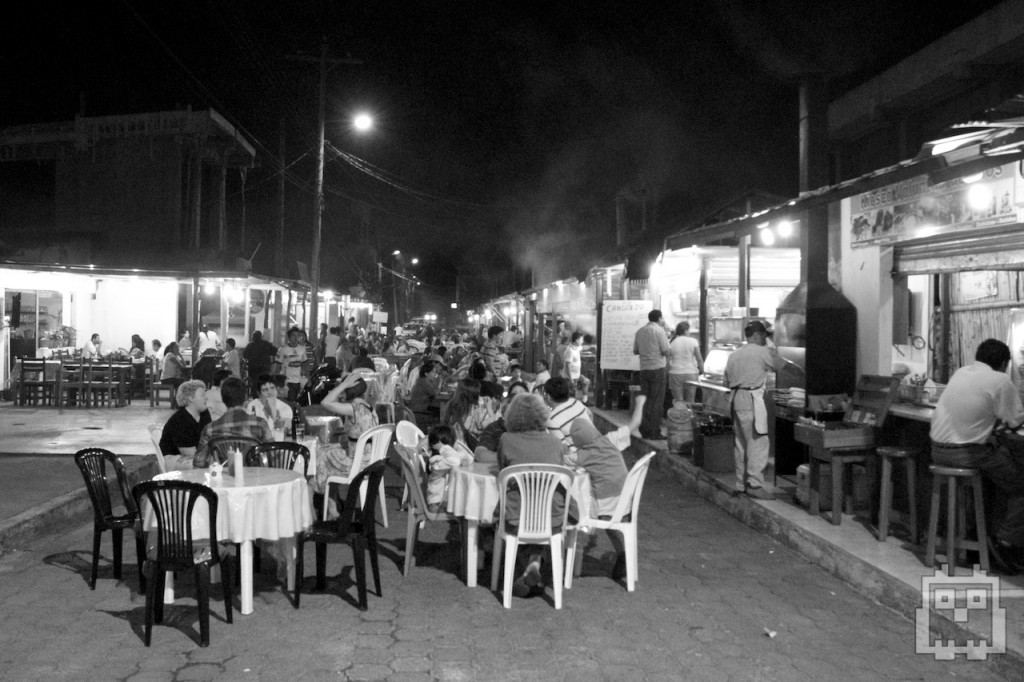
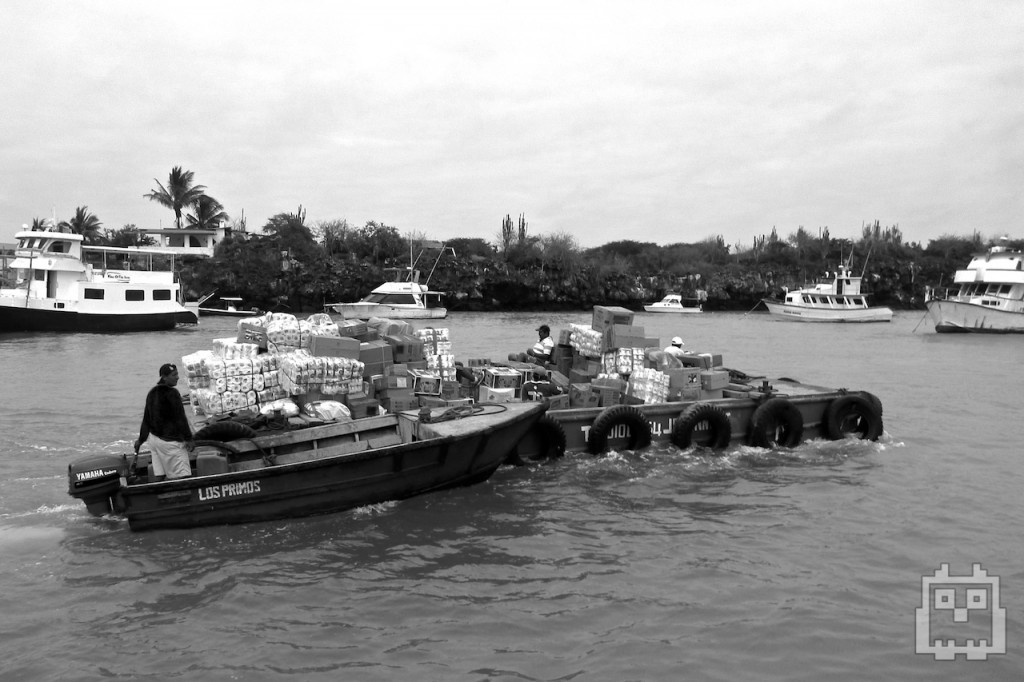
Awesome photos, Zach (as always). Dave is on his way back from Hawaii and was very anxious to know how you were doing. We’re both so happy for you and glad you went for the big jump. Can’t wait to read more posts about your adventure!
The Galapagos sound amazing … what an accomplishment to sail there! Those whales had to be an experience you’ll never forget … glad they didn’t hit your boat! I’d be terrified and excited at the same time.
Good luck on the next leg of your journey!